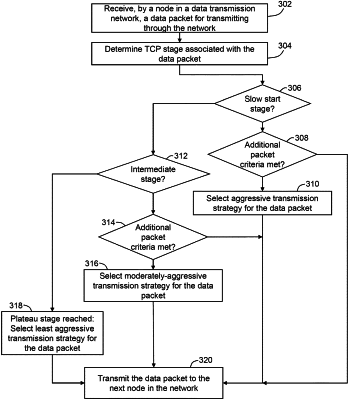| CPC H04L 47/12 (2013.01) [H04L 47/2466 (2013.01); H04L 69/163 (2013.01)] | 20 Claims |

|
1. A non-transitory computer readable medium comprising instructions which, when executed by one or more hardware processors, cause performance of operations comprising:
determining, by an intermediate node on a data transmission path, a first transmission control protocol (TCP) stage associated with a first data packet being transmitted from a source node on the data transmission path to a destination node on the data transmission path;
based on determining the first TCP stage corresponds to a slow-start stage, defined by a congestion window value that is increased at a first rate based on receiving acknowledgement messages from a destination node: selecting a first transmission strategy for transmitting, by the intermediate node, the first data packet to another node along the data transmission path;
transmitting, by the intermediate node, the first data packet in accordance with the first transmission strategy;
determining, by the intermediate node on the data transmission path, a second TCP stage associated with a second data packet received at the intermediate node;
based on determining the second TCP stage corresponds to a congestion-avoidance stage, defined by a congestion window value that is increased at a second rate based on receiving acknowledgement messages from the destination node: selecting a second transmission strategy for transmitting, by the intermediate node, the second data packet; and
transmitting, by the intermediate node, the second data packet in accordance with the second transmission strategy,
wherein the first transmission strategy is different than the second transmission strategy,
wherein the first transmission strategy corresponds to a first ratio of proactive data acceleration techniques to reactive data acceleration techniques,
wherein the second transmission strategy corresponds to a second ratio of proactive data acceleration techniques to reactive data acceleration techniques, and
wherein the first ratio is greater than the second ratio.
|